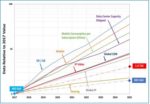It’s all about bandwidth these days – fueling hyperscale data centers that support high-performance and cloud computing applications. It’s what enables you to stream a movie on your smart TV while your roommate plays an online game with friends located in different parts of the country. It’s what makes big data analytics run swiftly… Read More
On-the-Fly Code Checking Catches Bugs Earlier
There’s no question that chip designs are getting more complex, driven by the power, performance, and area (PPA) demands of applications like artificial intelligence (AI), automotive, and cloud computing. This complexity, of course, trickles down to the design and testbench code. When engineers can find and fix bugs before… Read More
Upcoming Virtual Event: Designing a Time Interleaved ADC for 5G V2X Automotive Applications
Over the last decade or so, the automotive industry has been rapidly adopting and deploying innovative and revolutionary technologies in automobiles. One such revolution is the autonomous vehicle technology. While this technology is not fully mature yet, some components of this technology are. Many late model automobiles… Read More
Optimize RTL and Software with Fast Power Verification Results for Billion-Gate Designs
In every chip, power is a progressive problem to be solved. Designers have long had to rely on a combination of experience and knowledge to tackle this dilemma, typically having to wait until after silicon availability to perform power analysis with realistic software workloads. However, this is too late in the game, as it becomes… Read More
Driving PPA Optimization Across the Cubic Space of 3D IC Silicon Stacks
The move to true 3D IC, monolithic 3D SOC and 3D heterogeneous integration may require one of the most major design tool architecture overhauls since IC design tools were first developed. While we have been taking steps toward 3DIC with 2.5D designs with interposers, HBM, etc., the fundamental tools and flows remain intact in many… Read More
Die-to-Die Connections Crucial for SOCs built with Chiplets
If you ascribe to the notion that things move in circles, or concentrically, the move to die-to-die connectivity makes complete sense. Just as multi-chip modules (MCM) were the right technology decades ago to improve power, areas, performance and cost, the use of chiplets with die-to-die connections provides many advantages… Read More
Mars Perseverance Rover Features First Zoom Lens in Deep Space
On July 30, 2020, NASA launched the Mars 2020 Perseverance rover, which is scheduled to land today. Perseverance has been deployed to Mars with a new mission: to search for evidence of past life and collect samples that will eventually be brought back to Earth by future missions.
Verification Management the Synopsys Way
Remember the days when verification meant running a simulator with directed tests? (Back then we just called them tests.) Then came static and formal verification, simulation running in farms, emulation and FPGA prototyping. We now have UVM, constrained random testing and many different test objectives (functional, power,… Read More
Synopsys Debuts Major New Analog Simulation Capabilities
Just prior to this year’s Synopsys User Group (SNUG) meeting, I had a call with Hany Elhak, Group Director of Product Management and Marketing at Synopsys, to talk about their latest announcements for analog simulation. Synopsys usually has big things to talk about each year around this time – this year is no exception. Hany… Read More
Accelerating Cache Coherence Verification
It would be nice if there were a pre-packaged set of assertions which could formally check all aspects of cache coherence in an SoC. In fact, formal checks do a very nice job for the control aspects of a coherent network. But that covers only one part of the cache coherence verification task. Dataflow checks are just as important, where… Read More










